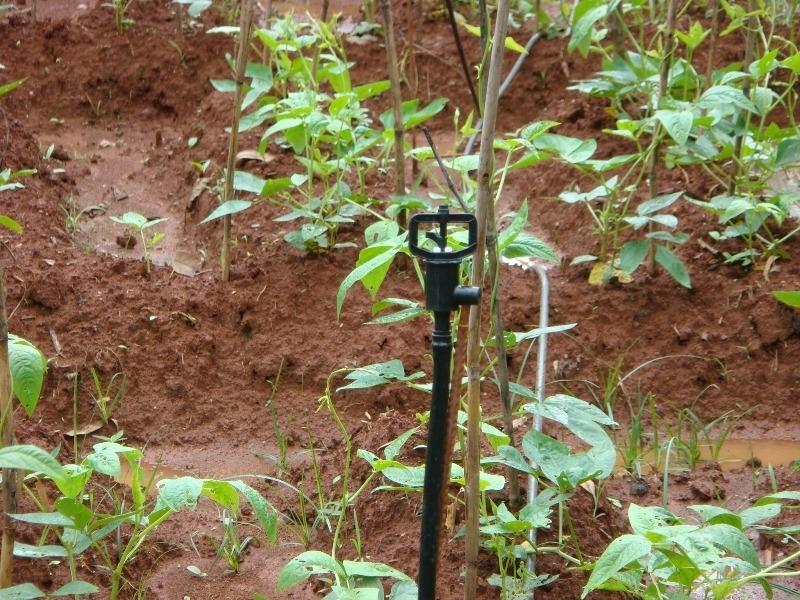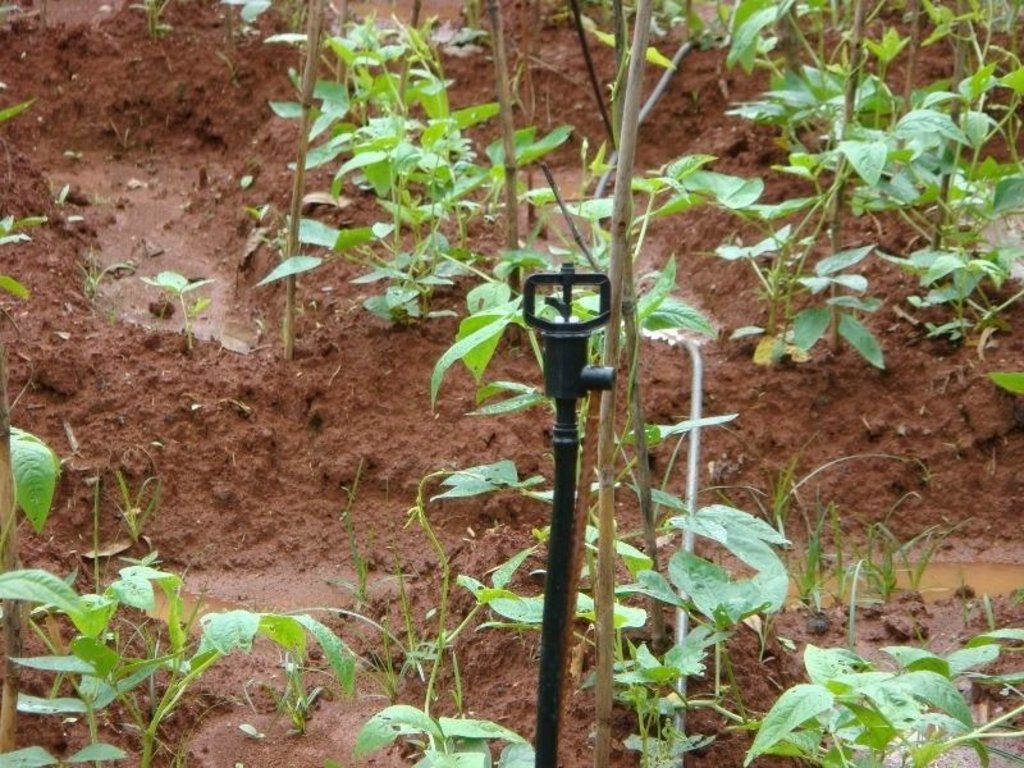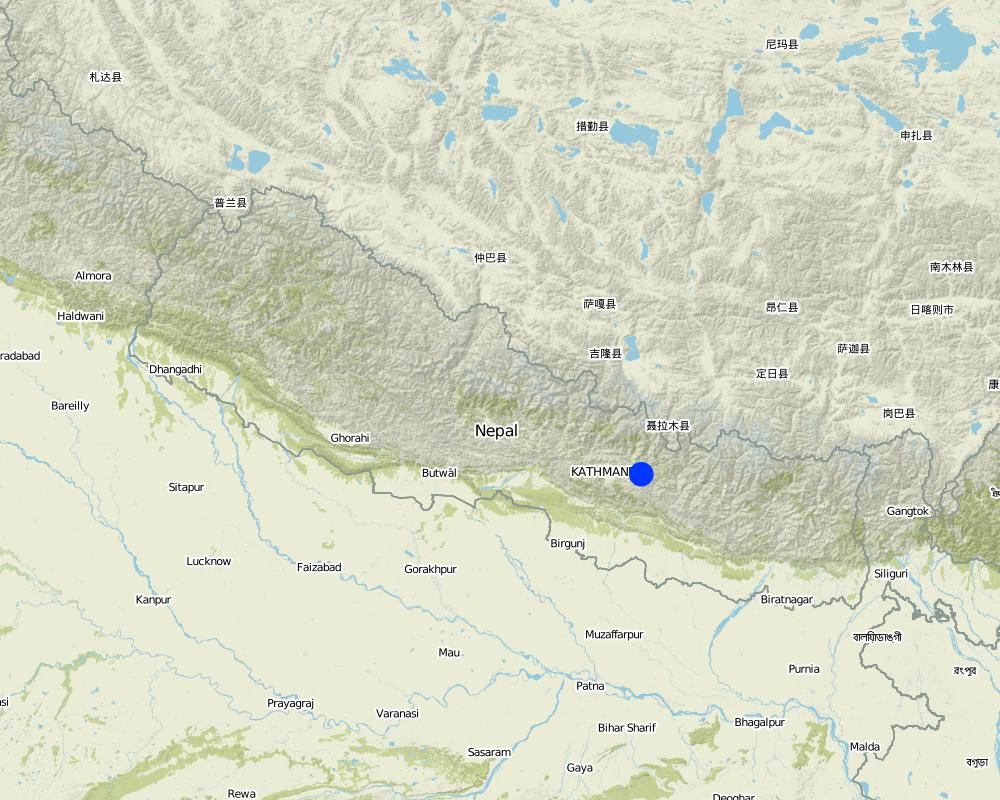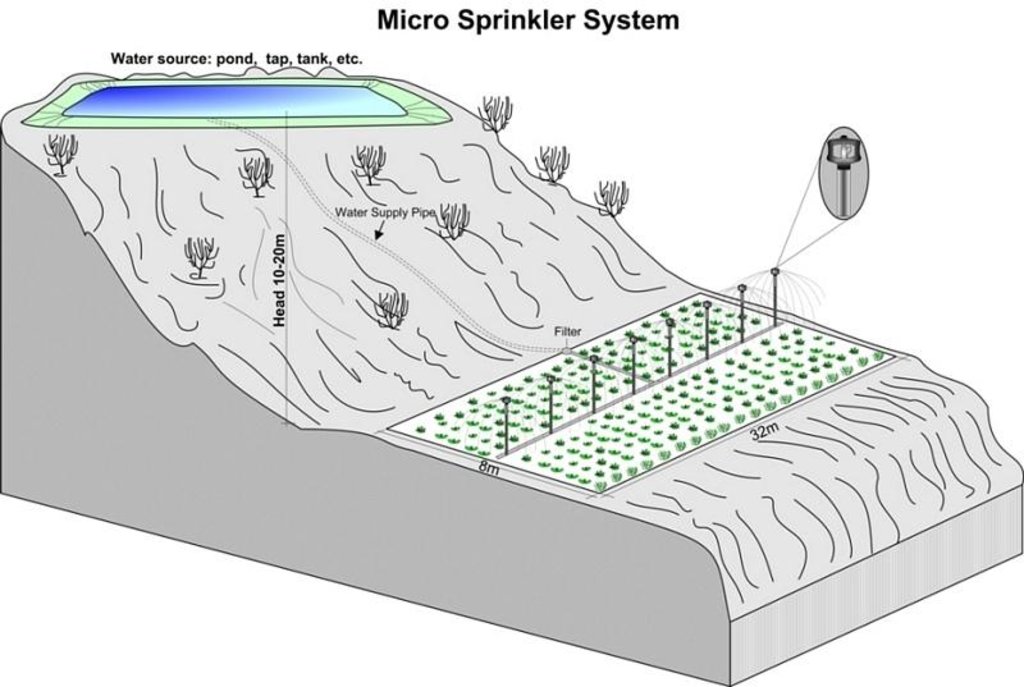Low cost micro-sprinkler irrigation [Nepal]
- Creation:
- Update:
- Compiler: Madhav Dhakal
- Editor: –
- Reviewers: David Streiff, Alexandra Gavilano
Phohara sinchai - Nepali
technologies_1500 - Nepal
View sections
Expand all Collapse all1. General information
1.2 Contact details of resource persons and institutions involved in the assessment and documentation of the Technology
SLM specialist:
SLM specialist:
Name of the institution(s) which facilitated the documentation/ evaluation of the Technology (if relevant)
ICIMOD International Centre for Integrated Mountain Development (ICIMOD) - Nepal1.3 Conditions regarding the use of data documented through WOCAT
The compiler and key resource person(s) accept the conditions regarding the use of data documented through WOCAT:
Yes
2. Description of the SLM Technology
2.1 Short description of the Technology
Definition of the Technology:
An irrigation system that delivers small-sized water droplets through a rotating head allowing longer watering time with less runoff
2.2 Detailed description of the Technology
Description:
Micro-sprinkler irrigation is an efficient and alternative method of irrigation for high value cash crops. It has been demonstrated in the Jhikhu Khola watershed (JKW) in Nepal’s middle mountains by the People and Resource Dynamics in Mountain Watersheds of the Hindu Kush-Himalayas Project (PARDYP). The NGO International Development Enterprises (IDE-Nepal) has assisted private companies to assemble and market micro-irrigation systems.
Micro sprinklers are available in a variety of configurations. They operate at a low-pressure, with water delivered at a pressure equivalent to 10-20m of head, and at a low discharge rate of 0.1-0.2 lps - equivalent to the average discharge of a 1/2 inch size public tap. A pre-assembled micro-irrigation system generally consists of 4 to 8 sprinkler heads at 4m intervals connected by half inch piping. Micro sprinklers are most suitable for closely cropped vegetables like onion and garlic. PARDYP demonstrated, tested, and promoted the system to show land users the potential to use irrigation water very efficiently, which is important because water is in short supply for much of the year after the monsoon finishes in September. In the test area, much of the land is left fallow after the monsoon crops have been harvested as it is difficult to grow winter crops because of the lack of irrigation
water.
The system is easy to install and move around. It needs a reliable source of water, such as a water harvesting tank or a tap, located about 10-20m above the field to be irrigated. A water tank can be installed at the appropriate height to give an adequate water head. The preassembled micro-sprinkler heads are inserted into the ground on a support stand and are connected to the water source via a conveyance pipe. The water passes through a filter before entering the sprinkler heads to prevent the sprinklers becoming clogged up; the system needs regular cleaning.
2.3 Photos of the Technology
2.5 Country/ region/ locations where the Technology has been applied and which are covered by this assessment
Country:
Nepal
Further specification of location:
Kavrepalanchowk/ Jhikhu Khola watershed
Specify the spread of the Technology:
- evenly spread over an area
If precise area is not known, indicate approximate area covered:
- 0.1-1 km2
Map
×2.6 Date of implementation
If precise year is not known, indicate approximate date:
- less than 10 years ago (recently)
2.7 Introduction of the Technology
Specify how the Technology was introduced:
- through projects/ external interventions
Comments (type of project, etc.):
Pre-assembled micro-irrigation technology, which was demonstrated in the Which khola watershed, was developed by IDE/Nepal in 1998.
3. Classification of the SLM Technology
3.1 Main purpose(s) of the Technology
- Improve efficiency of water use
3.2 Current land use type(s) where the Technology is applied

Cropland
- Annual cropping
Annual cropping - Specify crops:
- cereals - maize
- legumes and pulses - other
- root/tuber crops - potatoes
- seed crops - sesame, poppy, mustard, other
- wheat, tomatoes
Number of growing seasons per year:
- 3
Specify:
Longest growing period in days: 150; Longest growing period from month to month: Jun - Oct; Second longest growing period in days: 120; Second longest growing period from month to month: Nov - Feb
Comments:
major cash crop: Tomato and potato
major food crop: Maize and wheat
other: Legumes and mustard
Major land use problems (compiler’s opinion): Insufficient irrigation water during winter and the pre-monsoon season (November-May). Insufficient farm income due to small landholdings, and soil health deterioration due to increased inputs of chemical fertilisers and agrochemicals.
Major land use problems (land users’ perception): Irrigation water shortage for the crops grown during winter and premonsoon months.
Type of cropping system and major crops comments: Maize- Wheat /vegetables
3.4 Water supply
Water supply for the land on which the Technology is applied:
- rainfed
3.5 SLM group to which the Technology belongs
- irrigation management (incl. water supply, drainage)
3.6 SLM measures comprising the Technology

management measures
- M2: Change of management/ intensity level
3.7 Main types of land degradation addressed by the Technology

soil erosion by water
- Wt: loss of topsoil/ surface erosion
Comments:
Main type of degradation addressed: Wt: loss of topsoil / surface erosion
Main causes of degradation: change of seasonal rainfall
Secondary causes of degradation: droughts
3.8 Prevention, reduction, or restoration of land degradation
Specify the goal of the Technology with regard to land degradation:
- reduce land degradation
4. Technical specifications, implementation activities, inputs, and costs
4.1 Technical drawing of the Technology
Technical specifications (related to technical drawing):
Micro-sprinkler irrigation system and technical specification.
Location: Patalekhet and Kuttal. Kavrepalanchowk district
Technical knowledge required for field staff / advisors: low
Technical knowledge required for land users: low
Main technical functions: increase / maintain water stored in soil, water spreading (efficiently)
Change of land use practices / intensity level: from conventional irrigation (flood / bucket) to efficient irrigation.
Author:
A.K. Thaku
4.2 General information regarding the calculation of inputs and costs
Specify how costs and inputs were calculated:
- per Technology unit
Specify unit:
Micro-sprinkler irrigation
Specify dimensions of unit (if relevant):
4 to 8 sprinkler heads at 4 m intervals
Specify currency used for cost calculations:
- USD
Indicate average wage cost of hired labour per day:
2.10
4.3 Establishment activities
| Activity | Timing (season) | |
|---|---|---|
| 1. | Identify an appropriate water source (water harvesting tank, tap, pump) | beginning of the growing season |
| 2. | Fix the micro-sprinkler heads in the ground with their support stands | growing season |
| 3. | Connect sprinkler system with water source through conveyance pipes | growing season |
4.4 Costs and inputs needed for establishment
| Specify input | Unit | Quantity | Costs per Unit | Total costs per input | % of costs borne by land users | |
|---|---|---|---|---|---|---|
| Labour | Installing micro-sprinkler system | Persons/unit | 2.0 | 2.1 | 4.2 | 100.0 |
| Equipment | Sprinkler heads, pipes etc. | unit | 1.0 | 12.2 | 12.2 | |
| Total costs for establishment of the Technology | 16.4 | |||||
| Total costs for establishment of the Technology in USD | 16.4 | |||||
Comments:
Duration of establishment phase: 6 month(s)
4.5 Maintenance/ recurrent activities
| Activity | Timing/ frequency | |
|---|---|---|
| 1. | Regular monitoring of the sprinklers’ performance | during irrigating period / regularly |
| 2. | Cleaning nozzles if clogging problem occurs | during irrigating period / regularly |
4.6 Costs and inputs needed for maintenance/ recurrent activities (per year)
| Specify input | Unit | Quantity | Costs per Unit | Total costs per input | % of costs borne by land users | |
|---|---|---|---|---|---|---|
| Labour | Maintaining sprinkler system | Persons/unit | 1.0 | 2.1 | 2.1 | 100.0 |
| Total costs for maintenance of the Technology | 2.1 | |||||
| Total costs for maintenance of the Technology in USD | 2.1 | |||||
Comments:
Machinery/ tools: measuring tape, hammer
The cost was calculated for unit technology with all necessary components (pipes, filter, fittings, stand ) and 4 micro sprinkler heads, which is sufficient to irrigate 250 sq. m. area. Cost estimated in 2006.
4.7 Most important factors affecting the costs
Describe the most determinate factors affecting the costs:
The system itself is a dominating factor affecting the cost.
5. Natural and human environment
5.1 Climate
Annual rainfall
- < 250 mm
- 251-500 mm
- 501-750 mm
- 751-1,000 mm
- 1,001-1,500 mm
- 1,501-2,000 mm
- 2,001-3,000 mm
- 3,001-4,000 mm
- > 4,000 mm
Specify average annual rainfall (if known), in mm:
1070.00
Agro-climatic zone
- humid
Thermal climate class: subtropics
5.2 Topography
Slopes on average:
- flat (0-2%)
- gentle (3-5%)
- moderate (6-10%)
- rolling (11-15%)
- hilly (16-30%)
- steep (31-60%)
- very steep (>60%)
Landforms:
- plateau/plains
- ridges
- mountain slopes
- hill slopes
- footslopes
- valley floors
Altitudinal zone:
- 0-100 m a.s.l.
- 101-500 m a.s.l.
- 501-1,000 m a.s.l.
- 1,001-1,500 m a.s.l.
- 1,501-2,000 m a.s.l.
- 2,001-2,500 m a.s.l.
- 2,501-3,000 m a.s.l.
- 3,001-4,000 m a.s.l.
- > 4,000 m a.s.l.
5.3 Soils
Soil depth on average:
- very shallow (0-20 cm)
- shallow (21-50 cm)
- moderately deep (51-80 cm)
- deep (81-120 cm)
- very deep (> 120 cm)
Soil texture (topsoil):
- medium (loamy, silty)
- fine/ heavy (clay)
Topsoil organic matter:
- medium (1-3%)
If available, attach full soil description or specify the available information, e.g. soil type, soil PH/ acidity, Cation Exchange Capacity, nitrogen, salinity etc.
Soil fertility is very low - low
Soil drainage / infiltration is medium
Soil water storage capacity is medium
5.4 Water availability and quality
Water quality (untreated):
poor drinking water (treatment required)
Comments and further specifications on water quality and quantity:
Water quality (untreated): Also good drinking water. More in rainy season (June- September), less in April/May; source: natural spring
5.6 Characteristics of land users applying the Technology
Market orientation of production system:
- mixed (subsistence/ commercial)
Off-farm income:
- 10-50% of all income
Relative level of wealth:
- poor
- average
Individuals or groups:
- individual/ household
Level of mechanization:
- manual work
Gender:
- women
- men
Indicate other relevant characteristics of the land users:
Land users applying the Technology are mainly common / average land users
Population density: 200-500 persons/km2
Annual population growth: 2% - 3%
15% of the land users are rich and own 35% of the land.
50% of the land users are average wealthy and own 25% of the land (as classified by the land users).
35% of the land users are poor and own 40% of the land.
Off-farm income specification: In most farm households, off-farm income plays at least a minor and increasingly a major role. Occasional opportunities for off-farm income present themselves in the form of daily
Market orientation of production system: Mostly vegetables.
Level of mechanization: Only vegetables are grown with this technology.
5.7 Average area of land used by land users applying the Technology
- < 0.5 ha
- 0.5-1 ha
- 1-2 ha
- 2-5 ha
- 5-15 ha
- 15-50 ha
- 50-100 ha
- 100-500 ha
- 500-1,000 ha
- 1,000-10,000 ha
- > 10,000 ha
Is this considered small-, medium- or large-scale (referring to local context)?
- medium-scale
Comments:
Average area of land owned or leased by land users applying the Technology: Also 2-5 ha.
5.8 Land ownership, land use rights, and water use rights
Land ownership:
- individual, titled
Land use rights:
- individual
Water use rights:
- open access (unorganized)
6. Impacts and concluding statements
6.1 On-site impacts the Technology has shown
Socio-economic impacts
Income and costs
farm income
Comments/ specify:
due to increased vegetable production
Socio-cultural impacts
community institutions
Comments/ specify:
an informal network of sprinkler users formed
SLM/ land degradation knowledge
livelihood and human well-being
Comments/ specify:
vegetableproduction became possible with use of less water, production increased.
Ecological impacts
Soil
soil moisture
Comments/ specify:
due to precise delivery of water (0.1 - 0.2 lps)
soil loss
Comments/ specify:
due to uniform application of water to crops grown on slopping land
Other ecological impacts
Made the irrigation of multiple vegetables possible
Comments/ specify:
as users can shift the system around to irrigate
6.3 Exposure and sensitivity of the Technology to gradual climate change and climate-related extremes/ disasters (as perceived by land users)
Gradual climate change
Gradual climate change
| Season | increase or decrease | How does the Technology cope with it? | |
|---|---|---|---|
| annual temperature | increase | not known |
Climate-related extremes (disasters)
Meteorological disasters
| How does the Technology cope with it? | |
|---|---|
| local rainstorm | well |
| local windstorm | not well |
Climatological disasters
| How does the Technology cope with it? | |
|---|---|
| drought | well |
Hydrological disasters
| How does the Technology cope with it? | |
|---|---|
| general (river) flood | not well |
Other climate-related consequences
Other climate-related consequences
| How does the Technology cope with it? | |
|---|---|
| reduced growing period | well |
6.4 Cost-benefit analysis
How do the benefits compare with the establishment costs (from land users’ perspective)?
Short-term returns:
slightly positive
Long-term returns:
positive
How do the benefits compare with the maintenance/ recurrent costs (from land users' perspective)?
Short-term returns:
very positive
Long-term returns:
very positive
Comments:
The table shows the perceptions of land users who accepted the technology with incentives from the PARDYP project. The short-term benefits are positive even if users have to buy the system themselves.
6.5 Adoption of the Technology
- > 50%
If available, quantify (no. of households and/ or area covered):
515 households in an area of 0.1 - 1 sq km. (200 - 500 persons / sq km)
Of all those who have adopted the Technology, how many did so spontaneously, i.e. without receiving any material incentives/ payments?
- 91-100%
Comments:
3% of land user families have adopted the Technology with external material support
15 land user families have adopted the Technology with external material support
Comments on acceptance with external material support: survey results
97% of land user families have adopted the Technology without any external material support
500 land user families have adopted the Technology without any external material support
Comments on spontaneous adoption: survey results
There is a strong trend towards spontaneous adoption of the Technology
Comments on adoption trend: About 80% of the implementers explained that they have seen neighbors using the sprinkle system so there is a growing trend of adoption. Some farmers were using the technology even before it was introduced by the project.
6.7 Strengths/ advantages/ opportunities of the Technology
| Strengths/ advantages/ opportunities in the land user’s view |
|---|
| Sprinkler showers drive away insects |
| Is equally useful to irrigate fallow land to increase soil moisture. |
| Strengths/ advantages/ opportunities in the compiler’s or other key resource person’s view |
|---|
|
Extremely useful for closely spaced, leafy vegetables such as onions, garlic and spinach grown in small areas. How can they be sustained / enhanced? Suitable for row crops like bitter gourd during their initial stage of growth; and also good for a wide range of row crops (tree crops and vegetables) that require low-fl ow irrigation. |
|
Most appropriate for sloping land How can they be sustained / enhanced? Can be used on level land if tank placed at appropriate height |
|
Easy to transport, and possible to use for different crops in rotation How can they be sustained / enhanced? Position of the sprinkler head should be changed to acquire 100% overlap of watered areas. |
|
Allows uniform distribution of water and longer watering time with less runoff; therefore reduces soil loss from sloping land and increases soil moisture status. How can they be sustained / enhanced? The technology should be shared with a wider audience |
6.8 Weaknesses/ disadvantages/ risks of the Technology and ways of overcoming them
| Weaknesses/ disadvantages/ risks in the land user’s view | How can they be overcome? |
|---|---|
| Sometimes sprinklers stop functioning as they do not rotate and can become disconnected from the pipe | Regular checking and cleaning |
| Are susceptible to being stolen as they can be easily dismantled | Regular site visits by the farmer |
| Weaknesses/ disadvantages/ risks in the compiler’s or other key resource person’s view | How can they be overcome? |
|---|---|
| Requires sufficient head pressure therefore less suitable for plain lands. | It can be used in plain lands with alternative arrangements i.e. by constructing a platform for drum/ tank at appropriate height. |
7. References and links
7.1 Methods/ sources of information
7.2 References to available publications
Title, author, year, ISBN:
ICIMOD (2007) Good Practices in Watershed Management, Lessons Learned in the Mid Hills of Nepal. Kathmandu: ICIMOD
Available from where? Costs?
ICIMOD
Links and modules
Expand all Collapse allLinks
No links
Modules
No modules





